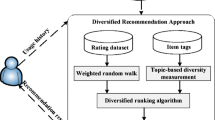Abstract
Recently there has been an increasing interest in applying random walk based methods to recommender systems. We employ a Gaussian random field to model the top-N recommendation task as a semi-supervised learning problem, taking into account the degree of each node on the user-item bipartite graph, and induce an effective absorbing random walk (ARW) algorithm for the top-N recommendation task. Our random walk approach directly generates the top-N recommendations for individuals, rather than predicting the ratings of the recommendations. Experimental results on the two real data sets show that our random walk algorithm significantly outperforms the state-of-the-art random walk based personalized ranking algorithm as well as the popular item-based collaborative filtering method.
Similar content being viewed by others
References
Baluja, S., Seth, R., Sivakumar, D., Jing, Y., Yagnik, J., Kumar, S., Ravichandran, D., Aly, M., 2008. Video Suggestion and Discovery for YouTube: Taking Random Walks through the View Graph. Proc. 17th Int. Conf. on www, Beijing, China, p.895–904. [doi:10.1145/1367497.1367618]
Brand, M., 2005. A Random Walks Perspective on Maximizing Satisfaction and Profit. Proc. SDM, p.12–19.
Breese, J.S., Heckerman, D., Kadie, C.M., 1998. Empirical Analysis of Predictive Algorithms for Collaborative Filtering. Proc. 14th Conf. on Uncertainty in Artificial Intelligence, University of Wisconsin Business School, Madison, Wisconsin, USA, p.43–52.
Cheng, H., Tan, P.N., Sticklen, J., Punch, W.F., 2007. Recommendation via Query Centered Random Walk on K-partite Graph. Proc. 7th IEEE Int. Conf. on Data Mining, Omaha, Nebraska, USA, p.457–462. [doi:10.1109/ICDM.2007.8]
Doyle, P., Snell, L., 1984. Random Walks and Electrical Networks. Mathematical Association of America.
Fouss, F., Pirotte, A., Renders, J.M., Saerens, M., 2007. Random-walk computation of similarities between nodes of a graph with application to collaborative recommendation. IEEE Trans. Knowl. Data Eng., 19(3):355–369. [doi:10.1109/TKDE.2007.46]
Fuxman, A., Tsaparas, P., Achan, K., Agrawal, R., 2008. Using the Wisdom of the Crowds for Keyword Generation. Proc. 17th Int. Conf on www, Beijing, China, p.61–70. [doi:10.1145/1367497.1367506]
George, T., Merugu, S., 2005. A Scalable Collaborative Filtering Framework Based on Co-clustering. Proc. 5th IEEE Int. Conf. on Data Mining, Houston, Texas, USA, p.625–628. [doi:10.1109/ICDM.2005.14]
Gori, M., Pucci, A., 2007. ItemRank: A Random-walk Based Scoring Algorithm for Recommender Engines. Proc. 20th Int. Joint Conf. on Artificial Intelligence, Hyderabad, India, p.2766–2771.
Huang, Z., Chen, H., Zeng, D.D., 2004. Applying associative retrieval techniques to alleviate the sparsity problem in collaborative filtering. ACM Trans. Inf. Syst., 22(1):116–142. [doi:10.1145/963770.963775]
Kunegis, J., Schmidt, S., 2007. Collaborative Filtering using Electrical Resistance Network Models. 7th Industrial Conf. on Data Mining, Leipzig, Germany, p.269–282. [doi:10.1007/978-3-540-73435-2_21]
Sarwar, B.M., Karypis, G., Konstan, J.A., Riedl, J., 2001. Item-based Collaborative Filtering Recommendation Algorithms. Proc. 10th Int. Conf. on www, Hong Kong, China, p.285–295. [doi:10.1145/371920.372071]
Singh, A.P., Gunawardana, A., Meek, C., Surendran, A.C., 2007. Recommendations Using Absorbing Random Walks. North East Student Colloquium on Artificial Intelligence (NESCAI).
Symeonidis, P., Nanopoulos, A., Papadopoulos, A.N., Manolopoulos, Y., 2008. Nearest-biclusters collaborative filtering based on constant and coherent values. Inf. Retr., 11(1):51–75. [doi:10.1007/s10791-007-9038-4]
Wang, J., Vries, A., Reinders, M., 2006. Unifying User-based and Item-based Collaborative Filtering Approaches by Similarity Fusion. Proc. 29th ACM SIGIR Conf., p.501–508. [doi:10.1145/1148170.1148257]
Yildirim, H., Krishnamoorthy, M.S., 2008. A Random Walk Method for Alleviating the Sparsity Problem in Collaborative Filtering. Proc. 2008 ACM Conf. on Recommender Systems, Lausanne, Switzerland, p.131–138. [doi:10.1145/1454008.1454031]
Zhu, X., Ghahramani, Z., Lafferty, J., 2003. Semi-supervised Learning Using Gaussian Fields and Harmonic Functions. Proc. 20th Int. Conf. on Machine Learning, Washington DC, USA, p.912–919.
Author information
Authors and Affiliations
Corresponding author
Additional information
Project supported by the National Natural Science Foundation of China (Nos. 60525108 and 60533090), the National Hi-Tech Research and Development Program (863) of China (No. 2006AA010107), and the Program for Changjiang Scholars and Innovative Research Team in University, China (No. IRT0652)
Rights and permissions
About this article
Cite this article
Zhang, Y., Wu, Jq. & Zhuang, Yt. Random walk models for top-N recommendation task. J. Zhejiang Univ. Sci. A 10, 927–936 (2009). https://doi.org/10.1631/jzus.A0920021
Received:
Accepted:
Published:
Issue Date:
DOI: https://doi.org/10.1631/jzus.A0920021




